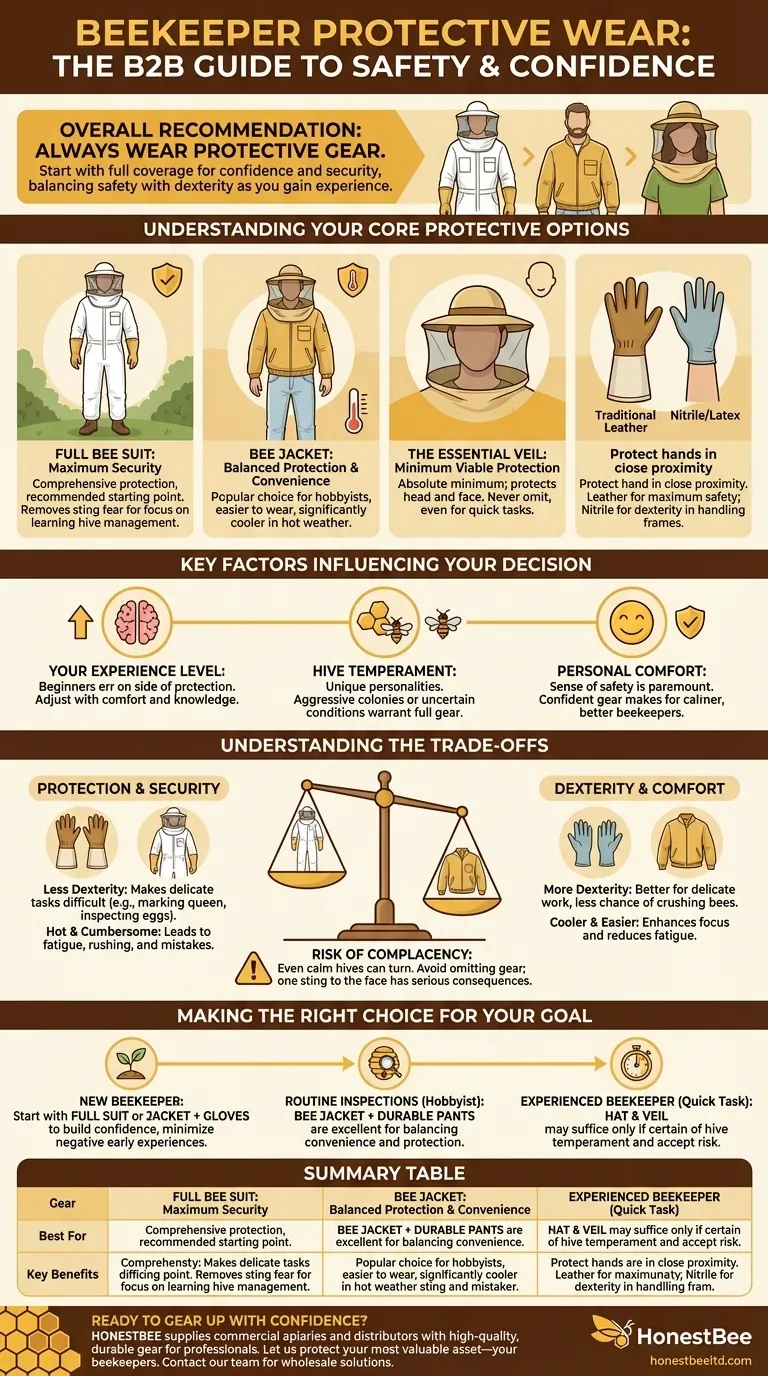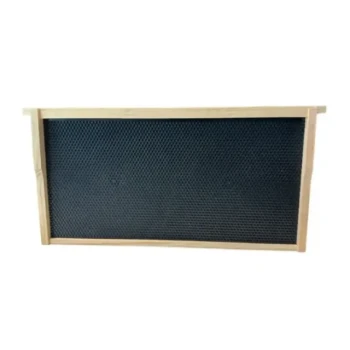The fundamental recommendation for all beekeepers, regardless of experience, is to always wear protective gear when working with your hives. While the level of protection may vary, starting with full coverage is the standard for beginners, as it builds confidence and provides crucial security against stings when you are least familiar with bee behavior.
The decision is not if you should wear protective gear, but rather how much gear is appropriate for your experience level, the temperament of your bees, and your personal comfort. It is a calculated balance between absolute safety and practical dexterity.

Understanding Your Core Protective Options
Your choice of gear directly impacts your safety and comfort. Each option serves a specific purpose, and most beekeepers end up owning more than one type as their experience grows.
The Full Bee Suit: Maximum Security
A full bee suit is a single garment that covers you from your ankles to your wrists, typically with a veil integrated into the hood. It offers the most comprehensive protection available.
This is the recommended starting point for all new beekeepers. The complete coverage removes the fear of stings, allowing you to focus on learning hive management and understanding bee behavior.
The Bee Jacket: A Balance of Protection and Convenience
A bee jacket protects your entire upper body, including your head and face via an attached veil. Beekeepers typically wear this with a durable pair of light-colored jeans or work pants.
This is often the go-to choice for many hobbyists after their first season. It is easier to put on and take off than a full suit and is significantly cooler in hot weather.
The Essential Veil: Minimum Viable Protection
A hat and veil combination is the absolute minimum piece of protective equipment you should ever use. It protects your face, head, and neck, which are the most dangerous and painful places to be stung.
Experienced beekeepers may use only a veil for very quick tasks like filling a feeder, but it should never be omitted.
Gloves: Protecting Your Hands
Gloves protect your hands, which are in constant and close proximity to the bees. Traditional leather beekeeping gloves offer maximum protection but can be clumsy.
Many beekeepers opt for thinner nitrile or latex gloves over leather. This offers a barrier against stings while preserving the dexterity needed to handle frames and equipment delicately.
Key Factors Influencing Your Decision
The right gear for you depends on a few critical variables. What works for a seasoned professional may not be appropriate for someone in their first year.
Your Experience Level
Beginners should err on the side of more protection. As you become more comfortable, read your bees' temperament, and learn your own tolerance for the occasional sting, you can adjust your gear accordingly.
Hive Temperament
Every hive has a unique personality. Some are exceptionally docile, while others are more defensive. An aggressive colony or uncertain conditions always warrant gearing up with full protection.
Personal Comfort
Your sense of safety is paramount. If you are nervous or anxious, bees can sense it. Wearing gear that makes you feel confident and protected will make you a calmer, better beekeeper.
Understanding the Trade-offs
Choosing beekeeping gear involves balancing competing priorities. Being aware of these trade-offs is key to making an informed decision.
Protection vs. Dexterity
More protection, especially from thick gloves, means less dexterity. This can make it difficult to perform delicate tasks like marking a queen or inspecting a frame for eggs, potentially leading you to crush bees accidentally.
Security vs. Comfort
A full bee suit offers maximum security but can be extremely hot and cumbersome, especially during summer. This can lead to fatigue and rushing, which are common causes of mistakes in the apiary.
The Risk of Complacency
As beekeepers gain experience, there is a temptation to wear less gear. While this can be acceptable, it's crucial to avoid complacency. Even the calmest hive can become defensive if conditions change, and a single bad sting to the eye or face can have serious consequences.
Making the Right Choice for Your Goal
Your path in beekeeping will guide your gear choices over time. Use these principles as your starting point.
- If you are a new beekeeper: Start with a full suit or a jacket/pant combination and gloves to build confidence and minimize negative early experiences.
- If you value convenience for routine inspections: A bee jacket paired with durable, light-colored pants is an excellent and popular choice for most hobbyists.
- If you are an experienced beekeeper performing a quick task: A simple hat and veil may suffice, but only if you are certain of the hive's temperament and accept the risk.
Choosing the right gear is the first step in building a safe and rewarding relationship with your bees.
Summary Table:
| Protective Gear | Best For | Key Benefits |
|---|---|---|
| Full Bee Suit | Beginners, Defensive Hives | Maximum security, full-body coverage, builds confidence |
| Bee Jacket | Hobbyists, Routine Inspections | Balanced protection & comfort, cooler in hot weather |
| Hat & Veil | Quick Tasks, Experienced Beekeepers | Protects face/neck, minimal gear for fast jobs |
| Gloves | All Beekeepers | Hand protection; choose leather for max safety or nitrile for dexterity |
Ready to Gear Up with Confidence?
Choosing the right protective wear is the foundation of safe and successful beekeeping. At HONESTBEE, we supply commercial apiaries and beekeeping equipment distributors with high-quality, durable gear designed for professionals. Whether you need reliable full suits for your team or versatile jackets for daily inspections, our wholesale-focused operations ensure you get the equipment you need.
Let us help you protect your most valuable asset—your beekeepers. Contact our team today to discuss your specific needs and get a quote on our range of beekeeping supplies and equipment.
Visual Guide

Related Products
- Beekeeping Jacket with Hood and Veil for Beekeepers
- Economy Polyester Beekeeping Jacket with Veil and Hat
- Square Folding Bee Hat Veil with String for Beekeeping
- Heavy Duty Cowboy Beekeeper Hat with Visibility Veil Outdoor Professional Beekeeping Protective Gear
- Beekeeper Cowboy Hat and Veil for Beekeeping
People Also Ask
- What are the cons of wearing a bee jacket? Understanding the Protection Trade-Offs
- What should I wear under a bee suit? Essential Clothing for Maximum Protection & Comfort
- What should be considered when choosing the fabric weight of a beekeeping suit? Prioritize Safety & Comfort for Your Apiary
- What are the advantages of using a beekeeping jacket instead of a full suit? Unlock Speed and Comfort
- What are the features of an economical beekeeping jacket? Essential Protection for Budget-Conscious Beekeepers



















